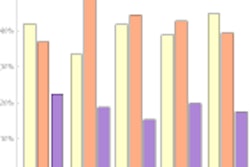Many radiologists are putting in more hours in order to handle greater procedure volume, according to a new survey by the Radlinx Group, an Irving, TX-based firm specializing in off-site teleradiology services. However, harder work and rising volumes are not necessarily translating into more revenue.
The survey confirms what most radiologists are experiencing on a daily basis -- that imaging volumes are heading upward. Eighty-three percent of private-practice radiologists surveyed indicated that volumes in their practices increased in the last year, while 12% said volumes remained the same, and only 3% said volumes declined (2% did not answer).
And although a majority of radiologists saw rising volumes in their practices, less than half indicated that revenues in their practices had increased. Close to 30% indicated revenues had decreased while 24% indicated revenues remained the same (2% did not answer).
When volumes go up but revenues do not, it is a clear sign that reimbursement is going down. In fact, "declining reimbursement" was identified as a number one priority for the next year by more radiologists surveyed than any other factor, as the graph below illustrates.
| Radiologists' top priorities over the next 12
months (1 indicates highest priority) | ||||
| 1 | 2 | 3 | N/A | |
| Declining reimbursement | 61% | 33% | 4% | 2% |
| Upgrading/transitioning to digital/PACS/teleradiology | 54% | 25% | 18% | 3% |
| Staffing radiologists and technologists | 52% | 37% | 10% | 1% |
| Improving report turnaround/patient throughput | 46% | 33% | 19% | 2% |
| Rising malpractice rates | 45% | 42% | 11% | 2% |
| Improving patient service | 36% | 51% | 10% | 3% |
| Improving relations with referring physicians | 31% | 49% | 17% | 6% |
| Outsourcing night/weekend call and/or coverage | 21% | 25% | 48% | 6% |
Staffing still a challenge
Volumes continue to rise at a time when staffing shortages in radiology are still very much a fact of life for many radiologists. Fifty-seven percent of radiologists surveyed indicated that they were "overburdened" due to increasing volumes and/or understaffing in their practices.
Those radiologists who indicated they are overburdened by rising volumes and understaffing are coping in the following ways:
| How
radiologists are dealing with rising volumes and/or staffing
shortages | |
| Working longer hours | 47% |
| Actively recruiting radiologists | 46% |
| Using locum tenens radiologists | 16% |
| Using or considering off-site alternatives | 11% |
| Planning to retire in the next year | 5% |
| Planning to relocate | 2% |
| Other | 4% |
Not surprisingly, radiologists are reading more studies per year today than in 2002, when the Radlinx Group conducted a similar survey in conjunction with its affiliate company, U.S. Radiology Partners.
| Average
number of studies radiologists read per year | ||
| 2004 | 2002 | |
| 0 - 5,000 | 0% | 4% |
| 5,001 - 10,000 | 7% | 16% |
| 10,001 - 15,000 | 23% | 29% |
| 15,001 - 20,000 | 41% | 32% |
| Over 20,000 | 26% | 16% |
| N/A | 3% | 3% |
As the graph indicates, 48% of radiologists surveyed were reading 15,000 or more studies per year in 2002. By 2004, 67% of radiologists said they were reading 15,000 or more studies per year.
Staffing eases for techs, but not for radiologists
Staffing of radiologic technologists appears to have improved somewhat compared to 2002, though it is still a challenge for many radiologists. In 2002, 56% of radiologists surveyed said they had an insufficient number of technologists. By contrast, in 2004, only 40% of radiologists said they were understaffed in technologists. Thus, the "maximum red alert" in technologist staffing appears to have eased to a mere "red alert," in which four out of 10 radiology practices remain understaffed.
Staffing of radiologists has also improved, but not by much. Forty-nine percent of radiologists surveyed in 2002 indicated they had an insufficient number of radiologists. In 2004, 48% of those surveyed reported that they were understaffed in radiology -- though 4% indicated they were overstaffed (no one surveyed in 2002 indicated they were overstaffed).
Understaffing continues to diminish quality of care, the survey suggested. Twenty-nine percent of radiologists surveyed indicated that staffing shortages in their practices were diminishing the quality of care they are able to provide by limiting patient access or delaying turnaround times (down slightly from 33% in 2002).
Teleradiology as a way to cope
An increasing number of radiologists are using teleradiology to cope with rising volumes and to provide 24-hour coverage, the survey indicates. Eighty-seven percent of radiologists surveyed are using teleradiology in their practices, up from 70% in 2002. The majority of these (74%) are using teleradiology for nighttime call and coverage. Meanwhile, 28% are using teleradiology to outsource to off-site radiologists, up from 24% in 2002. Enhanced technology and the continued shortage of technologists are driving the trend toward sending studies to remote, off-site radiologists.
While most radiologists use teleradiology for nighttime coverage, the survey indicates that many radiologists need additional coverage during the day. Thirty-seven percent said that due to overwhelming volumes, understaffing or other reasons, they need additional daytime coverage.
The offshore controversy
There is growing controversy with regard to jobs of all types being outsourced overseas. In fact, radiology may be the most complex "upper-end" job currently being outsourced offshore. However, this trend is still in the incipient stages, and at this point only a small percentage of studies are going overseas.
Nevertheless, 64% of radiologists surveyed indicated that they believe the practice of sending studies overseas is inappropriate, while 30% said it is appropriate, and 6% declined to answer the question.
Even in an era of increasing volumes and decreasing reimbursement, the majority of radiologists surveyed do not seem to have an urgent desire to stop practicing. When asked if they would retire tomorrow if they could, 50% said no, 39% said yes, and 11% were not sure.
Why quit when you’re having fun?
By Phillip MillerAuntMinnie.com contributing writer
April 15, 2004
Click here for complete survey results.
Phillip Miller is a healthcare writer and consultant based in Dallas. He provides consulting services to Radlinx. He can be reached at [email protected].
Related Reading
Survey predicts big loss of practitioners to retirement, changing work patterns, December 23, 2003
Salary offers to radiologists jump 11%, July 14, 2003
Radiologists tough to recruit, survey finds, February 25, 2003
Copyright © 2004 AuntMinnie.com



















